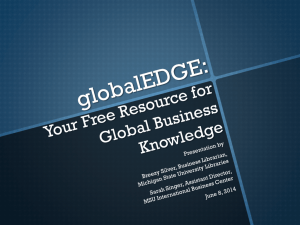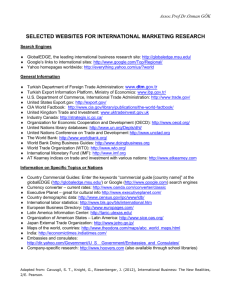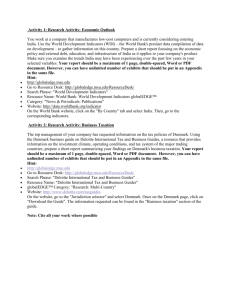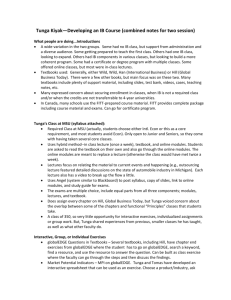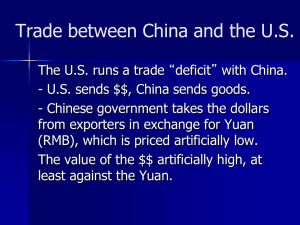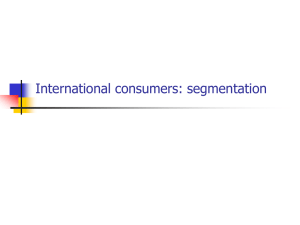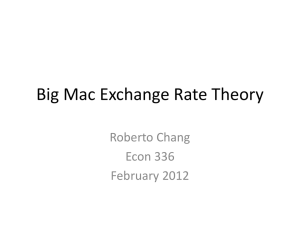Teaching International Marketing
advertisement
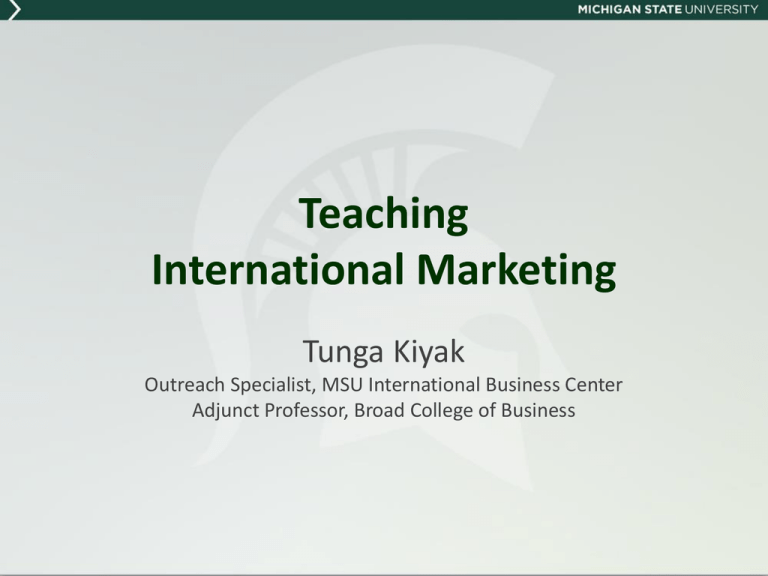
Teaching International Marketing Tunga Kiyak Outreach Specialist, MSU International Business Center Adjunct Professor, Broad College of Business Framework for International Marketing Primary analysis is outside in but the levels interact with each other. Product Place Price Promotion Level 1 Environmental Factors Political and Legal P Economic E Social and Cultural S Technological T Environmental E Level 1 – Environmental Factors Political and Legal P Economic E Social and Cultural S Technological T Environmental E Sample Factors: • Political Risk • Government stability • Employment law • Trade barriers and restrictions • Business regulations • Commercial law • Bureaucracy • Taxation policies • Intellectual property protection • Bribery and corruption Level 1 – Environmental Factors Political and Legal P Economic E Social and Cultural S Technological T Environmental E Sample Factors: • Economic composition • GDP Trends and growth • Interest rates • Disposable income • Credit availability • Employment costs • Economic risk factors • Transportation infrastructure • Energy costs and infrastructure Level 1 – Environmental Factors Political and Legal P Economic E Social and Cultural S Technological T Environmental E Sample Factors: • Demographics • Income distribution / social classes • Educational levels • Religion • Language • Attitudes and beliefs • Lifestyles • Consumerism • Workforce mobility • Worker rights and benefits Level 1 – Environmental Factors Political and Legal P Economic E Social and Cultural S Technological T Environmental E Sample Factors: • Basic infrastructure • Communications infrastructure • Network connectedness • R&D spending • Adoption diffusion patterns • Speed of transfer • Rate of obsolescence Level 1 – Environmental Factors Political and Legal P Economic E Social and Cultural S Technological T Environmental E Sample Factors: • Environmental awareness and sensitivity • Environmental protection regulations • Pollution levels • Waste management • Attitudes towards green or ecological products • Presence of environmental groups Application Idea • Country Reports – Assign or let the student select a product – Assign or let the student select a country – Conduct a comprehensive analysis of PESTE factors, conduct a SWOT analysis of these factors • Resources from globalEDGE to assist the task: – Country Insights Pages – World Bank Doing Business Indicators – Country Commercial Guides – Deloitte International Tax and Business Guides Market Analysis and Selection • Objective: To reduce the number of countries that warrant in-depth investigation as potential target markets. Identification of 5-6 high potential country markets that are the most promising to the firm. Market Potential Index Ranking the market potential of emerging markets for US Exporters. Updated annually at http://globaledge.msu.edu/mpi/ Additional Topics of Discussion/Emphasis • • • • Importance of cultural similarity/familiarity Targeting regions vs. individual countries Gateway countries and regional hubs Variations in screening depending on entry strategy (e.g., exporting vs. direct investment vs. licensing/franchising) • Variations in screening based on industry/product MPI as an Application Idea Excel spreadsheet for student projects: - Assign an industry/company - Let students determine dimensions and weights - Let students collect and analyze their own data Level 2 Marketing Strategy Market Segmentation Identify distinct groups of customers whose purchasing behavior differs from others in important ways Market Targeting Evaluate segments and decide which to go after Market Positioning Design a strategy and develop a marketing mix that will create a competitive advantage in the minds of the selected target market Primary Issues in Market Segmentation • The structure of market segments – Type of user (e.g., consumer, corporate, educational) – Demographic segmentation (age/gender/income) – Psychographic segmentation (attitudes/values) – Behavior segmentation (usage rate/adoption style) • Existence of segments that transcend national borders – Ever-growing due to the Internet and social media Market Targeting • Marketers evaluate the attractiveness of each potential segment and decide which of these groups they will try to turn into customers – Mass (standardized) – Concentrated (niche) – Differentiated (multi-segment) – Custom • Dependent on both segments identified and resources available. Discussion: Hidden Champions • Companies that hold #1 or #2 position in their respective industry in the world. • Usually earn more than 50% of their revenues from exports. • Many of them are still family-owned (thus relatively low profile) • May never show up in Fortune Global 500, etc. because they are not big enough companies (in terms of revenue). Sample Hidden Champions • Hohner – Harmonicas and accordions – 85% market share. Established in Germany in 1857. First products were sold to the U.S. • Haribo – Confectioner, best known for gummi bears. Established in 1920. almost went bankrupt during World War II. Still the biggest manufacturer of gummi and jelly sweets. • Joh. Barth & Sohn – Largest private hop grower and processor, the number one merchant, trading and processing roughly 40% of the world's hop production. Established in 1794 in Germany. Currently operates as Barth-Haas group after a number of mergers. • Tetra – Fish food – 50 year old company, developed a market share over 50%. All production still in Germany, has only warehouses in the U.S. (purchased by Spectrum Brands in 2005) • St. Jude Medical – 60 percent market share in artificial heart valves. Strategy for Success • Follow a super-niche strategy: they define their markets very narrowly, but go very deep in that niche market – Union Knopf – only manufactures buttons, but 250,000 different kinds • “It is better to be a large fish in a small pond, then be a small fish in a large pond with lots of sharks” • In many cases, they actually create their own markets by combining customer needs with product/technology approaches. • They emphasize R&D and innovation in their approach. Market Positioning • Developing and communicating a marketing strategy aimed at influencing how a particular market segment perceives a product or service in comparison to the competition – Attribute / benefit (“ultimate driving machine”) – Quality / Price (Bose and Bang & Olufsen) – Celebrity Users • Positioning can be different in different target markets • Four common positioning errors – – – – Underpositioning: lack of differentiation Overpositioning: too narrow Confused: too many things to too many people Doubtful: consumer just doesn’t believe it Level 3 Marketing Mix Product Place Price Promotion Key challenges are: • Resolving the trade-off between standardization and adaptation of the individual elements • Coordination of Marketing Activities across multiple markets Standardization vs. Adaptation Product • Products may require significant adaptation because of one of the following three: – Cultural differences • Tradition, language, religion, education, social structure – Economic differences • Number of features and performance expectations – Technical and regulatory standards • Metric vs. Imperial (US) units; voltage; safety standards • Frequently used as trade-barriers • Sample globalEDGE Resource: Interpower Domino’s Pizza: One Brand – One System Worldwide – Marketing: Same brand, logo and consumer promise – Operations: Same layouts, training and people focus – Quality Control: Same core products, audits and approved local suppliers Local Product Adaptations: International Toppings Taiwan: “Seafood Delight” with onions, peas, squid, shrimp and crab France: “Four-Cheese” pizza with goat, emmentaler, bleu and mozzarella cheeses South Korea: “Potato Pizza” with onions, bacon, mushrooms, corn, pepperoni, extra cheese and…mayonnaise!!! India: Spicy chicken sausage replaces pepperoni and beef products due to Hindu reverence for the cow Place • Distribution systems differ across markets: – – – – Retail concentration (concentrated vs. fragmented) Channel length (number of intermediaries) Channel exclusivity (ease of accessing channels) Channel quality • Sample globalEDGE Resources: – Global Retail Development Index (A.T. Kearney) – Logistics Performance Index (World Bank) – Compendium of Trade Laws (Lexmark Intl) Price • Price discrimination – Charging what the market will bear • Pricing strategies – Penetration Pricing – Market Skimming – Cost-plus Pricing • Regulatory and economic factors – Currency fluctuations – Anti-dumping and price fixing regulations, price ceilings Application Idea The Economist Big Mac Index A lighthearted guide to measure which currencies are overvalued and which ones are under-valued, based on PPP. Purchasing-power parity (PPP): A dollar (or local currency equivalent to a dollar) should buy the same amount of goods in all countries. In China, Big-Mac was 16 Yuan in Jan 2013 16.0 Yuan / 6.22 Yuan/USD = $2.57 In US, a Big Mac is $4.37 So, the exchange rate should really be 16 Yuan / 4.37 USD = 3.66 Yuan / USD $2.57/$4.37=0.59 so, the Yuan is 41% under-valued Discussion: What are the potential problem with this approach? Promotion • Cultural and Legal Barriers – An ad that works in one culture may not work in another – Comparative advertising is illegal in certain markets • Country of origin effects – Emphasize/de-emphasize origin • Noise levels – amount of promotional activity in the market competing for the customer’s attention • Push vs. Pull strategies – personal selling vs. mass media – Depends on product type, channel length, customer sophistication, and media availability • Internet and Social Media – Can be a benefit, but can also be disastrous for a brand Application Idea Best Global Brands (Interbrand/Business Week) THANK YOU! Tunga Kiyak Outreach Specialist, MSU International Business Center Email: kiyaktun@broad.msu.edu http://globalEDGE.msu.edu/

